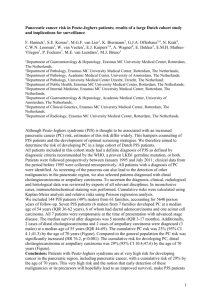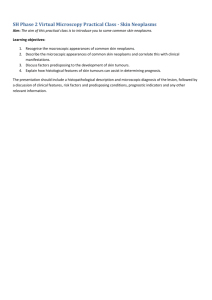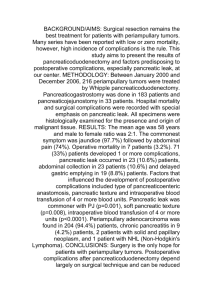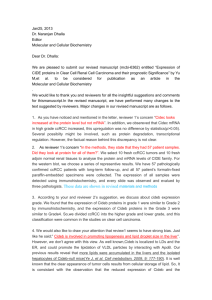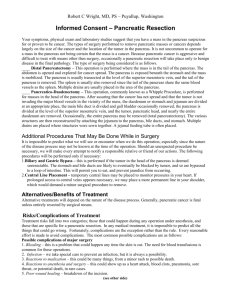{acinar cell carcinoma} – case report
advertisement
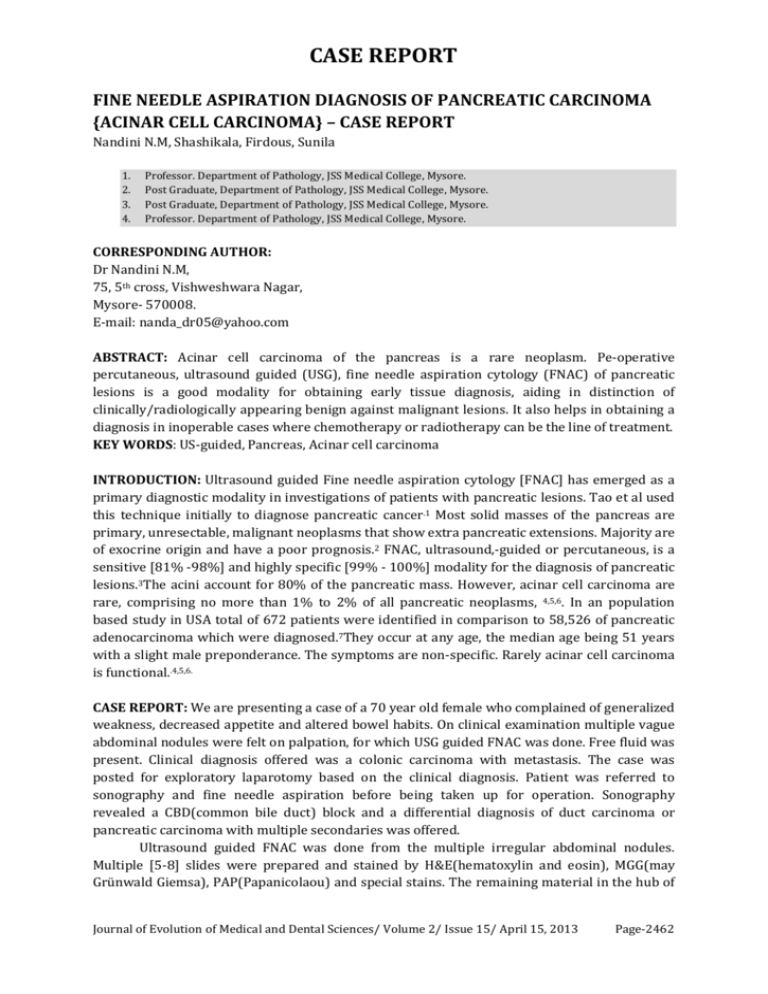
CASE REPORT
FINE NEEDLE ASPIRATION DIAGNOSIS OF PANCREATIC CARCINOMA
{ACINAR CELL CARCINOMA} – CASE REPORT
Nandini N.M, Shashikala, Firdous, Sunila
1.
2.
3.
4.
Professor. Department of Pathology, JSS Medical College, Mysore.
Post Graduate, Department of Pathology, JSS Medical College, Mysore.
Post Graduate, Department of Pathology, JSS Medical College, Mysore.
Professor. Department of Pathology, JSS Medical College, Mysore.
CORRESPONDING AUTHOR:
Dr Nandini N.M,
75, 5th cross, Vishweshwara Nagar,
Mysore- 570008.
E-mail: nanda_dr05@yahoo.com
ABSTRACT: Acinar cell carcinoma of the pancreas is a rare neoplasm. Pe-operative
percutaneous, ultrasound guided (USG), fine needle aspiration cytology (FNAC) of pancreatic
lesions is a good modality for obtaining early tissue diagnosis, aiding in distinction of
clinically/radiologically appearing benign against malignant lesions. It also helps in obtaining a
diagnosis in inoperable cases where chemotherapy or radiotherapy can be the line of treatment.
KEY WORDS: US-guided, Pancreas, Acinar cell carcinoma
INTRODUCTION: Ultrasound guided Fine needle aspiration cytology [FNAC] has emerged as a
primary diagnostic modality in investigations of patients with pancreatic lesions. Tao et al used
this technique initially to diagnose pancreatic cancer.1 Most solid masses of the pancreas are
primary, unresectable, malignant neoplasms that show extra pancreatic extensions. Majority are
of exocrine origin and have a poor prognosis.2 FNAC, ultrasound,-guided or percutaneous, is a
sensitive [81% -98%] and highly specific [99% - 100%] modality for the diagnosis of pancreatic
lesions.3The acini account for 80% of the pancreatic mass. However, acinar cell carcinoma are
rare, comprising no more than 1% to 2% of all pancreatic neoplasms, 4,5,6. In an population
based study in USA total of 672 patients were identified in comparison to 58,526 of pancreatic
adenocarcinoma which were diagnosed.7They occur at any age, the median age being 51 years
with a slight male preponderance. The symptoms are non-specific. Rarely acinar cell carcinoma
is functional..4,5,6.
CASE REPORT: We are presenting a case of a 70 year old female who complained of generalized
weakness, decreased appetite and altered bowel habits. On clinical examination multiple vague
abdominal nodules were felt on palpation, for which USG guided FNAC was done. Free fluid was
present. Clinical diagnosis offered was a colonic carcinoma with metastasis. The case was
posted for exploratory laparotomy based on the clinical diagnosis. Patient was referred to
sonography and fine needle aspiration before being taken up for operation. Sonography
revealed a CBD(common bile duct) block and a differential diagnosis of duct carcinoma or
pancreatic carcinoma with multiple secondaries was offered.
Ultrasound guided FNAC was done from the multiple irregular abdominal nodules.
Multiple [5-8] slides were prepared and stained by H&E(hematoxylin and eosin), MGG(may
Grünwald Giemsa), PAP(Papanicolaou) and special stains. The remaining material in the hub of
Journal of Evolution of Medical and Dental Sciences/ Volume 2/ Issue 15/ April 15, 2013
Page-2462
CASE REPORT
the L.P (lumbar puncture) needle was processed for cellblock. Special stains like PAS (Periodic
Acid Schiff), PAS with diastase and Mucicarmine were done.
On cytology, smears were highly cellular. Tumor cells were arranged in acinar pattern,
with abundant eosinophilic granular cytoplasm. The nuclei were large, crowded and contained
visible prominent nucleoli. Background showed individual tumour cells with inflammatory cells
and necrotic material [Fig.1]. Cells were PAS positive with resistance to diastase. Mucicarmine
stain was negative.
Cell block was stained by routine H & E. The section studied showed tumour cells
arranged in solid sheets and acinar patterns. Most tumour cells had scant to moderate amount
of eosinophilic and granular cytoplasm, relatively uniform and centrally located nuclei which
were small and had conspicuous nucleoli [Fig.2]. Based on the cytology, cell block features and
also taking the clinical history with radiological features into consideration a differential
diagnosis of pancreatic acinar cell carcinoma and duct carcinoma was offered.
DISCUSSION: Even though acinar cell carcinoma of pancreas account for only 1% to 2% of
pancreatic carcinoma 4,5 their prognosis is poor, with a 10% 5 year survival 5,8.
The closest differential diagnosis to acinar cell carcinoma is pancreatic endocrine
tumours [PET]. esp. Islet cell tumours. The other differential diagnosis to acinar cell carcinoma
are pancreatoblastoma and solid pseudo papillary tumours of pancreas [SPT]1,4,7,9
Cytological features go against SPT and pancreatoblastoma esp. the latter which occurs
in childhood4,10. Mucin stains like mucicarmine are positive in duct carcinoma. They are negative
in acinar cell carcinoma as it was found in the present case4. In acinar cell carcinoma there is
immunoreactivity for Trypsin, Lipase and less commonly for Chymotrypsin and Amylase. A
minor endocrine component identifiable by chromogranin is present in one third to one half of
the cases6,10. i.e. 30% to 40% of cases show focal positivity in acinar cell carcinoma 8, while islet
cell tumours show diffuse positivity with chromogranin 8. Immunocytochemistry using
chromogranin was done on the cell block.
The present case showed focal positivity on cell block section, for chromogranin.
We could not send the case for electron microscopy. Thus cytomorphological features
with immunocytochemistry helped to confirm the diagnosis of pancreatic acinar cell carcinoma
9,11. The patient was not operated upon and was referred to a cancer centre for radiation
therapy.
Thus preoperative percutaneous USG FNAC of pancreatic lesions is a good modality for
obtaining early tissue diagnosis aiding in distinction of clinically and radiologically appearing
benign v/s malignant lesions. A spectrum of pancreatic lesions can be diagnosed by the
technique and it carries a sensitivity of 81% and specificity of 100% 1,12. Also in cases where
disease is unresectable, chemotherapy, radiotherapy, or a combination of these modalities may
be used to increase overall quality of life as it was noted in our case13.
CONCLUSION: USG guided FNAC of pancreas is a safe, efficacious method to obtain material
from pancreatic tumours. It also helps to give diagnosis by cytology along with ancillary
methods like cell block and immunocytochemistry. It is a useful diagnostic aid in surgically
inoperable cases.
REFERENCE:
1. Bhatia P, Srinivasan R, Rajwanshi A, Nijhwan R, Khandelural N, Wig J,Vasishtha
R.K(2008) 5 year review and Reappraisal of ultrasound-guided percutaneous
Journal of Evolution of Medical and Dental Sciences/ Volume 2/ Issue 15/ April 15, 2013
Page-2463
CASE REPORT
2.
3.
4.
5.
6.
7.
8.
9.
10.
11.
12.
13.
Transabdominal Fine Needle Aspiration of Pancreatic Lesions Acta Cytologica, 52:523529.
Jose A, Heffernan J, Vieandi B, Ferrer P.L, Peramato P.G, Campus A.P,Viguer J.M: Fine
Needle Aspiration Cytology of Endocrine Neoplasms of thePancreas, Morphological and
Immuno cyto chemical findings in 20 cases. Actacytol; 48:295-301.
Jhala N.C, Jhala D.N, Chhieng D.C, Eloubeidi M.A, Eltoun I.A(2004) Endoscopic
ultrasound-guided Fine Needle aspiration A cytopathologist’s perspective AmJ. Clin
Pathol 2003;120: 351-367
Zaman M.B. The Pancreas. Koss Cytology and its Histopathologic Basisedition 5, Vol 1,
Editor Koss L.G, Melamed M.R, Lippincott Williams andWilkins, 2006, 1446-1447.
Klimstra D.S, Heffers C.S(1992) Acinar Cell Carcinoma of the Pancreas. A
clinicopathologic study of 28 cases : Am J Surg Pathol;, 16:815-837.
Hoorens A, Lemoine N.R, Mclellan E, Morohoshi T, Kamisawa T, Heitz P.U, Stamm B,
Ruschoff J, Wiedanmans B, Kloppal G(1993 ).Pancreatic Acinar cellCarcinoma. An
analysis of cell lineage markens, p53 expression and krasmutation Am J pathol, 143:685698.
Wisnoski NC, Townsend CM Jr, Nealon WH, Freeman JL, Riall TS(2008).672 patients
with acinar cell carcinoma of the pancreas: a population-based comparison to pancreatic
adenocarcinomaSurgery.;144(2):141-8.
Kloppel G, Klimstra D.S : Tumours of exocrine pancreas Edition 3rd vol,Editor, Fletcher
CDM. Diagnostic Histopathology of Tumours; ChurchillLivingstone 2007, 476-477.
Pend HQ, Darwin P, Papadimitriou JC, Drachanberg C.B(2006)Liver Metastasis of
Pancreatic acinar cell carcinoma with marked nuclear atypia and
pleomorphismdiagnosed by EUS FNA Cytology: A case report with emphasis on FNA
cytological findings. CytoJournal;3: 29.
Rosai.J. Pancreas and ampullary region, Surgical Pathology 9th Ed, Vol1, Edited Rosai
and Ackraman; Mosby 1080-1082. 10. Samual L.H, Friersen H.F
Fine needle aspiration cytology of Acinar cell Carcinoma of the Pancreas: a report of
Two Cases. Acta Cytol, 1996, 40; 585-591.
Brugge W.R(2004 ) .Pancreatic Fine Needle Aspiration. To do or not to do? Journal of
Pancreas (Online); 5,282-288.
Non k. W, Wallae M.B( 2005 ) Endoscopic ultrasound guided fine needle aspiration in
the diagnosis and staging of pancreatic adenocarcinoma Med Gen Med, , 25, Medscape .
FIG1 FNAC showing tumour cells arranged
in acinar pattern(H &E, 400)
FIG2 chromogranin positivity seen on cell block
confirming the diagnosis of acinar cell carcinoma
pancreas.(400x)
Journal of Evolution of Medical and Dental Sciences/ Volume 2/ Issue 15/ April 15, 2013
Page-2464

